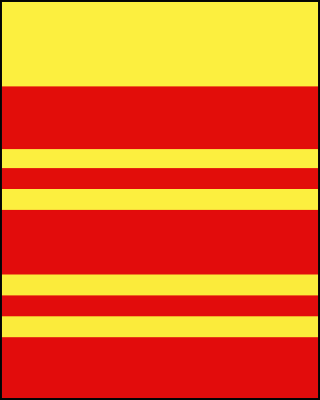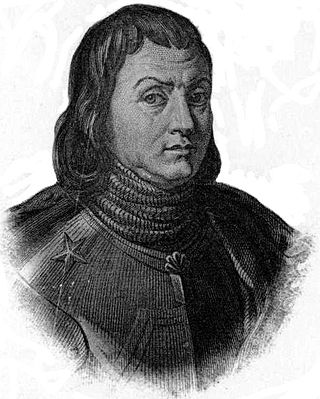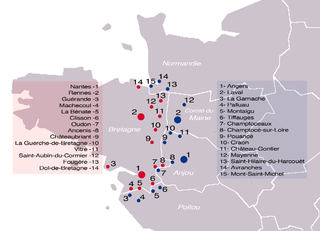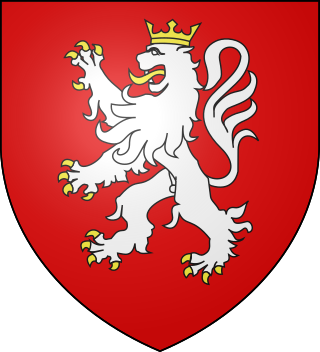
The Duchy of Brittany was a medieval feudal state that existed between approximately 939 and 1547. Its territory covered the northwestern peninsula of Europe, bordered by the Atlantic Ocean to the west, and the English Channel to the north. It was also less definitively bordered by the river Loire to the south, and Normandy, and other French provinces, to the east. The Duchy was established after the expulsion of Viking armies from the region around 939. The Duchy, in the 10th and 11th centuries, was politically unstable, with the dukes holding only limited power outside their own personal lands. The Duchy had mixed relationships with the neighbouring Duchy of Normandy, sometimes allying itself with Normandy, and at other times, such as the Breton–Norman War, entering into open conflict.

John IV the Conqueror KG, was Duke of Brittany and Count of Montfort from 1345 until his death and 7th Earl of Richmond from 1372 until his death.

Francis II was Duke of Brittany from 1458 to his death. He was the grandson of John IV, Duke of Brittany. A recurring theme in Francis' life would be his quest to maintain the quasi-independence of Brittany from France. As such, his reign was characterized by conflicts with King Louis XI of France and with his daughter, Anne of France, who served as regent during the minority of her brother, King Charles VIII. The armed and unarmed conflicts from 1465 to 1477 and 1484–1488 have been called the "War of the Public Weal" and the Mad War, respectively.

The now-extinct title of Earl of Richmond was created many times in the Peerage of England. The earldom of Richmond was initially held by various Breton nobles; sometimes the holder was the Breton duke himself, including one member of the cadet branch of the French Capetian dynasty. The historical ties between the Duchy of Brittany and this English earldom were maintained ceremonially by the Breton dukes even after England ceased to recognize the Breton dukes as earls of England and those dukes rendered homage to the King of France, rather than the English crown. It was then held either by members of the English royal families of Plantagenet and Tudor, or English nobles closely associated with the English crown. It was eventually merged into the English crown during the reign of Henry VII of England and has been recreated as a Dukedom.

The House of Rohan is a Breton family of viscounts, later dukes and princes in the French nobility, coming from the locality of Rohan in Brittany. Their line descends from the viscounts of Porhoët and is said to trace back to the legendary Conan Meriadoc. Through the Porhoët family, the Rohans are related to the Dukes of Brittany, with whom the family intermingled again after its inception. During the Middle Ages, it was one of the most powerful families in the Duchy of Brittany. The Rohans developed ties with the French and English royal houses as well, and they played an important role in French and European history.
This is a list of the Counts and Dukes of Étampes, a French fief.

In the 11th and 12th centuries the Countship of Penthièvre in Brittany belonged to a branch of the sovereign House of Brittany. It initially belonged to the House of Rennes. Alan III, Duke of Brittany, gave it to his brother Eudes in 1035, and his descendants formed a cadet branch of the ducal house.

The House of Montfort-Brittany was a Breton-French noble family, which reigned in the Duchy of Brittany from 1365 to 1514. It was a cadet branch of the House of Dreux; it was thus ultimately part of the Capetian dynasty. It should not be confused with the older House of Montfort which ruled as Counts of Montfort.

The Battle of Saint-Aubin-du-Cormier took place on 28 July 1488, between the forces of King Charles VIII of France, and those of Francis II, Duke of Brittany, and his allies. The defeat of the latter signalled the end to the "guerre folle", a feudal conflict in which French aristocrats revolted against royal power during the regency of Anne de Beaujeu. It also effectively precipitated the end of the independence of Brittany from France.

Rieux is a commune in the Morbihan department, Brittany, northwestern France.
When the Viking chieftain Rollo obtained the territories via the Treaty of Saint-Clair-sur-Epte which would later make up Normandy, he distributed them as estates among his main supporters. Among these lands were the seigneurie of Harcourt, near Brionne, and the county of Pont-Audemer, both of which Rollo granted to Bernard the Dane, ancestor of the lords (seigneurs) of Harcourt. he first to use Harcourt as a name, however, was Anquetil d'Harcourt at the start of the 11th century.

The Château de Brest is a castle in Brest, Finistère, France. The oldest monument in the town, it is located at the mouth of the river Penfeld at the heart of the roadstead of Brest, one of the largest roadsteads in the world. From the Roman castellum to Vauban's citadel, the site has over 1700 years of history, holding right up to the present day its original role as a military fortress and a strategic location of the highest importance. It is thus the oldest castle in the world still in use, and was classified as a monument historique on 21 March 1923.

Jean III de Brosse was Count of Penthièvre from 1480 until his death. He was the elder son of Jean II de Brosse and Nicole, Countess of Penthièvre.

Jean II de Brosse, also Jehan II de Brosse, was the elder son of Jean I de Brosse, Marshal of France. He would become chamberlain of the king of France in 1449. He married Nicole, Countess of Penthièvre, daughter of Charles, Seigneur d'Avaugour and Isabeau de Vivonne. Nicole later brought him, through inheritance in 1479, the County of Penthièvre in the Duchy of Brittany.

The House of Laval is a family of barons, later counts, coming from the town of Laval, located in Northwestern France, part of the province of Maine before the French Revolution. The Laval were one of the most powerful families of Maine during the Middle Ages and also had a presence in Brittany, where their prestige was similar to that of the Rohan. The House of Laval played a significant role in Breton history and during the Hundred Years War and the French Wars of Religion. They also favored the French Renaissance in Northwestern France, building several châteaux. The last male heir died during the 17th century, and his possessions went to the House of La Trémoille.

Jeanne de Clisson (1300–1359), also known as Jeanne de Belleville and the Lioness of Brittany, was a French/Breton noblewoman who became a privateer to avenge her husband after he was executed for treason by King Philip VI of France. She crossed the English Channel targeting French ships and often slaughtering their crew. It was her practice to leave at least one sailor alive to carry her message of vengeance.

Jean II de Rieux Breton Lord of Rieux, Rochefort and Ancenis, initially in the service of Brittany, but also eventually a Marshal of France in the service of King Charles VI. He was the great-grandfather of Jean IV de Rieux.

The French–Breton War lasted from 1487 to 1491. The cause of this war was the approaching death of the Breton Duke Francis II of Brittany, who had no clear successor. If not resolved, this meant a resumption of issues from a previous War of the Breton Succession (1341–1364), which had rival claimants allying with England or France, resulting in an ambiguous peace treaty that failed to prevent future succession disputes.

Nicole was Countess of Penthièvre from 1454 until her death.

Olivier IV de Clisson, was a Breton Marche Lord and knight who became embroiled in the intrigue of Vannes and was subsequently executed by the King of France for perceived treason. He was the husband of Jeanne de Clisson who eventually became known as the Lioness of Brittany.


















